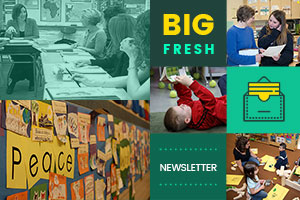The past beats inside me like a second heart.
John Banville
In Writing Alone and with Others, Pat Schneider shares how she often launches a first writing group with adults. She brings in a covered basket of random objects to serve as writing prompts. She explains how she removes the cover and introduces the activity:
I say, Now if you already have in mind what you want to write, just ignore my exercise. I’m going to put out some objects. I want you to choose an object—just choose something you’d like to hold in your hand. If you don’t know why, that’s good—it’s best that way. Take the object to your chair, hold it in your hands, and see what memories or images come to mind. Then write anything that comes to you. Be free to stop and start. Remember, you are making an artist’s sketch.
She then silently pulls out a few of the 50 objects in the basket, like a man’s shaving brush, a seashell, a baseball. When she pulls out a bra, there can be a humorous comment, so she stops and reminds everyone to keep the silence. It helps memories emerge. Everyone then takes an object that has evoked a memory and writes for 20 minutes.
This activity can also work well with teachers to evoke positive and negative memories of books. Think of what might happen if you uncovered a basket and then silently held up Silas Marner and Charlotte’s Web and To Kill a Mockingbird and Hamlet and Tuck Everlasting, one after the other with a long pause to think about each. Like Schneider, you can also encourage participants to write about any book that evokes a strong memory from school, even if it is not in the basket.
The hardest part of getting teachers to write can be helping them access a vivid memory that gets them itching to write. There is something powerful about taking a physical book in hand and remembering the time and place when you were introduced to it. There are challenging discussions worth having about what’s gained and lost when everyone reads the same book, or what place the classics have in schools today. Starting with strong memories, good and bad, is a terrific place to begin.
This week we continue our three-week series on read alouds, with a focus on troubleshooting problems. Plus more as always—enjoy!
Brenda Power
Founder, Choice Literacy

Katherine Sokolowski uses read alouds early in the year to help students reflect on how to be kind and thoughtful members of a classroom community.
Jennifer Schwanke shares her experience of having read-aloud go awry in a middle school classroom.
Are you unhappy with written response to read alouds in your classroom? Mary Lee Hahn suggests “one-pagers” as a fun alternative to traditional notebook responses.
Our newest online courses focus on classroom libraries and English language learners. Gradual Release of the Classroom Library with Bitsy Parks will help classroom teachers design minilessons and strategies for introducing students to the classroom library over time. English Language Learners and Literacy Instruction with Stella Villalba will give you tools and strategies for working with young learners from different cultures. If you’re a Choice Literacy member, you’ll receive 20-40% discounts off the course fees.
Our back-to-school DVD flash sale runs till September 9, with discounts of up to 70% on all titles. For this sale, you must purchase online and we can ship only to U.S. addresses. You can browse titles and sale prices at this link.

New members-only content is added each week to the Choice Literacy website. If you’re not yet a member, click here to explore membership options.
Franki Sibberson asks a critical question: Do students need to love the read alouds we share in classrooms? She works to move students beyond shallow like/don’t like responses to books.
Are your conversations during read aloud stilted or shallow? Tammy Mulligan recommends weekly “grand conversations” to spark more thoughtful talk. She provides the tools you need to get started in your classroom.
Mark Levine combines reading and thinking aloud in a minilesson to help his middle school students grapple with complex texts.
In this encore video from a fourth-grade classroom, Gi Reed reads aloud Small as an Elephant by Jennifer Richard Jacobson. Gi continually checks in with her students, making sure they are visualizing, noticing new vocabulary, and making connections to earlier incidents in the texts—all without breaking the flow of the story.

Lead Literacy now has a new home as the Leaders Lounge at Choice Literacy. We’ll be posting the new content updates here in the Leaders Lounge section of the Big Fresh newsletter.
Stella Villalba observes an English language learner who is new to a classroom being pulled from read aloud for extra support. She explains why read aloud is essential for all students, no matter what their language skills are.
New PD2Go: In this workshop, you’ll view video of Franki Sibberson leading read aloud in her fifth-grade classroom and explore activities and structures to create more thoughtful read alouds in your own classroom.
Can you teach kindness? Jamil Zaki explains how he creates an “empathy gym” with workouts for his college students to help them develop compassion and understanding of others.
Last chance to sign up for our self-paced online course It’s a Cycle, Not a Hamster Wheel with Dana Murphy to improve everything from the way you advertise and launch your coaching cycles to assessing the work after it is completed. If you are a Literacy Leaders member, you receive a 40% discount off the course fee.
Quote It:
All conflict can be traced back to someone’s feelings getting hurt.
Liane Moriarty
That’s all for this week!



